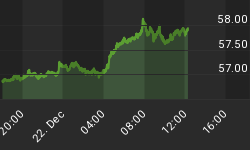In recent commentaries, I have emphasized that all asset markets, such as stocks and commodities, were significantly over-bought and that a meaningful correction would follow. Moreover, it was my view that technically, equity markets looked vulnerable and that some commodity markets - notably copper - had risen in a speculative blow-off. Ron Griess who provides some of the best economic and financial charts at www.Thechartstore.com recently showed how the three and five year's rate of change of copper had never been higher (see figure 1).
Figure 1: Copper: 3 Year Compound Annual Rate of Change
Source: Ron Griess, www.Thechartstore.com
There are two observations I should like to make regarding this remarkable figure. Since 1900, there has never been a three years period during which copper rose at an annual compound rate of close to 70%! Moreover, whenever the 3 year annual compound gain exceeded about 20%, the subsequent compound annual rate of change was between minus 15% and minus 20%. So, the likelihood that we have built some kind of bubble high - not only in copper but in all industrial commodities - is quite high!
The wider question of course for asset markets, such as equities and commodities, is whether we a currently dealing with just a correction in a rising trend or the beginning of a bear market. There are a few factors, which we need to take into consideration. For one, the period between May and October is a period of seasonal weakness in US equities (see figure 2).
Figure 2: Performance of S&P 500 between May and October, and November and April of each Year
Source: www.chartoftheday.com
Also, to consider is that the second year of the US presidential cycle, when mid term election take place, is usually a poor time for equities. As can be seen from figure 3, during mid-term election years the stock market has tended to decline between April and October of that year.
Figure 3: Average Mid-Term Election Year
Source: www.chartoftheday.com
Then, there are numerous technical indicators, which have flashed warning signals for quite some time. In the US, buying pressure has been diminishing while selling pressure has been increasing since the end of last year, while the stock market was still rising. Moreover, in recent weeks - that is until the market began to sell-off, the US stock market was forming a rising wedge, which is usually followed by a severe break down in prices. The Bradley Model, which I described in the past, also turned down in mid May and is now going to decline until the end of November 2006 (see figure 4).
Figure 4: The Bradley Model, 2005 - 2007
Source: Arch Crawford
In fact, the US stock market was long overdue for a setback. Beginning in October 2002, the current run has lasted 1,318 days without a 10 percent drop in the S&P 500. That's the third-longest period in the index's history without a 10 percent correction. Lastly, the "Hindenburg Omen" has recently given several sell signals, according to Jim Miekka, who publishes the Sudbury Bull & Bear Report newsletter in St. Petersburg, Florida. Sell signals do occur when an unusually large numbers of stocks both reached one-year highs and lows but prices continue to climb. The Hindenburg Omen sell signals occur only seldom. They indicate a highly unstable stock market and whereas their record is not perfect, Hindenburg Omen sell signals preceded the crash of October 1987, the Long-Term Capital Management collapse of 1998, and the bursting of the "Internet bubble" in 2000.
So what should investors do? Since most stock markets recently became oversold on a very short term basis, a rebound got underway and may last somewhat longer. However, in most stock markets there is now huge overhead resistance, which will contain any significant advance and make it extremely difficult if not impossible for stock and also commodity markets to reach new highs for the next six months or so. For the S&P 500, the overhead resistance resides between 1295 and 1330 (see figure 5).
Figure 5: S&P 500 Index, 2005 - 2006
Source: www.decisionpoint.com
In fact, some asset markets like India, Russia, the Latin American stock markets, copper, and other industrial commodities, are so over-extended that further 30% declines would not surprise me. Therefore, my advice is to sell rallies in stocks and commodities and take a holiday until next October. This would particularly apply for the Indian stock market, where speculators are mostly heavily long....
My readers will know from previous reports that I am ultra bearish about US bonds for the long term. In fact, I recommend that each reader buy just one 30-Year US government bond, frame it and put it on his wall in his living room. You can then, in future, show your grandchildren how the US dollar and bonds became worthless. However, for the short term, I believe that the out-performance of equities compared to bonds, since 2003, has ended and that bonds will now rebound over the next three months (see figure 6). I may add that bond bullish sentiment reach recently extremely low levels while commercial had record long bond positions - a powerful contrary indictor, which would support my take that the US economy will shortly badly disappoint. I believe that the US government which has been extremely adept at misinforming the media and the public about the health of the economy will find it increasingly hard to "fool all the people all the time".
Figure 6: 30-Year US Treasury Bond (continuous contract).
Source: www.decisionpoint.com
Finally, for our Middle Eastern friends, I believe that for the next few weeks, their extremely over-sold stock markets could rebound around 20% to 30% (see figure 7). New highs are, however, out of the question.
Figure 7: Saudi Arabia Stock Exchange Index
Source: research@bmg.com.sa















